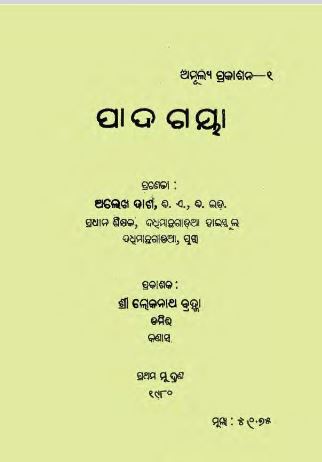Published in 1980, Padagaya by Alekha Das is a notable contribution to Odia literature, blending scholarly insights with a deep cultural exploration of the revered pilgrimage site of Gaya. This work eloquently examines the significance of Gaya, a city long celebrated in Hindu mythology as a sacred center for worship and rituals dedicated to the ancestors. Through his keen observations and evocative prose, Das invites readers on a compelling journey that resonates with themes of spirituality, heritage, and the rituals associated with the act of offering to the manes—known as “Tarpan.”
The book unfolds the notion of sub-pilgrimage, a term that encapsulates the broader experience of pilgrimage beyond the main destinations. In the context of Gaya, this sub-pilgrimage emphasizes the multifaceted aspects of both the physical journey to the site and the spiritual undertakings that accompany it. Das explores how the act of pilgrimage is not merely a geographical traversal but also a profound spiritual endeavor that enables devotees to connect with their roots and the divine. Through his exploration, he highlights the transformative power of these journeys, encouraging readers to reflect on their own spiritual pathways and the rituals that anchor them in their cultural narratives.
At the heart of Padagaya lies the significance of Gaya itself. This ancient city is imbued with layers of mythological importance, particularly surrounding the legends of Gayasura, a demonic figure transformed into a sacred land through divine intervention. The narrative of Gayasura serves as a captivating allegory, reflecting the triumph of good over evil and the eternal struggle of the soul towards liberation. Das elucidates the folklore surrounding this transformative tale, emphasizing how Gaya is not only a geographical locale but also a metaphorical space where the struggles of humanity are played out.
The book meticulously details the rituals associated with Gaya, especially the ancestral offerings that devotees perform in the hope of providing peace and solace to their forebears. Das’s writing captures the essence of Tarpan, narrating its significance as both an act of devotion and a cultural duty. He describes the sacred waters of the Falgu River and the rituals performed on its banks, creating vivid imagery that allows readers to feel the sanctity of the place. By sharing personal anecdotes and testimonies from pilgrims, Das brings the experience to life, demonstrating the deeply emotional resonance of these rituals for individuals and families seeking blessings from their ancestors.
Beyond its exploration of Gaya’s significance, “Padagaya” offers rich cultural commentary on the practices of devotion, the importance of remembering one’s roots, and the interconnectedness of past and present. Das’s prose invites readers to ponder the role of tradition in a rapidly changing world, emphasizing the enduring relevance of these rituals in shaping identity and community.
In conclusion, Padagaya by Alekha Das is a profound exploration of Gaya as a spiritual epicenter within the Odia cultural landscape. Through its thoughtful examination of pilgrimage, ancestral offerings, and mythological narratives, the book stands as a testament to the power of faith and the importance of honoring one’s heritage. It serves not only as a guide for those wishing to embark on their own spiritual journeys but also as a rich tapestry of ideas that encourages reflection on the timeless quest for spiritual and cultural understanding.
Books Info
| Books name | Padagaya |
| Author | Alekha Das |
| No Of pages | 13 |
| Publisher | Sri Lokanatha Brahma |
| Publication | 1980 |
| Printed At | NA |
| Distributor | NA |

